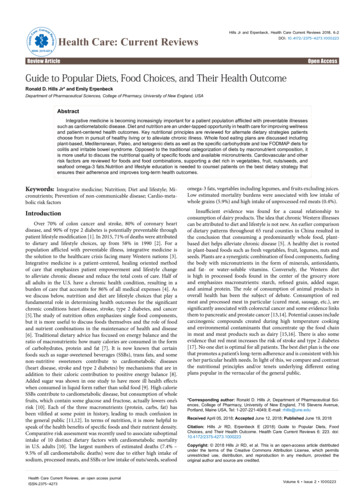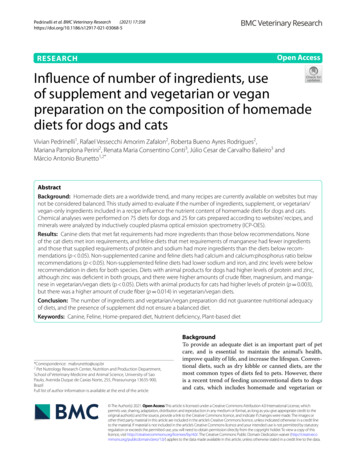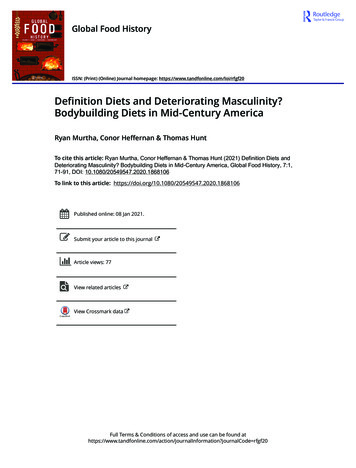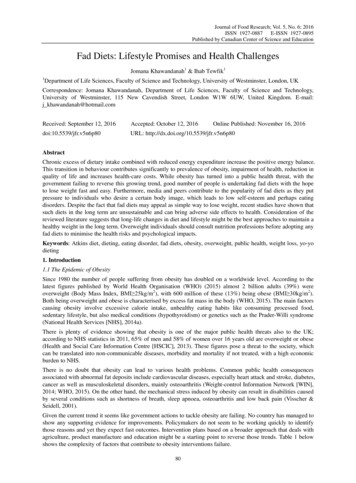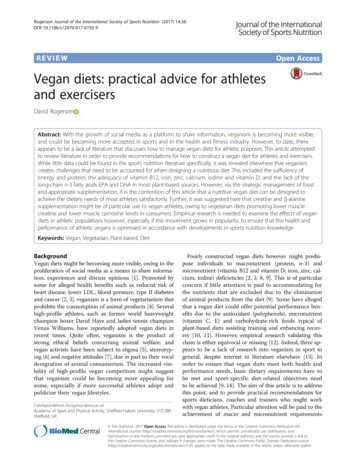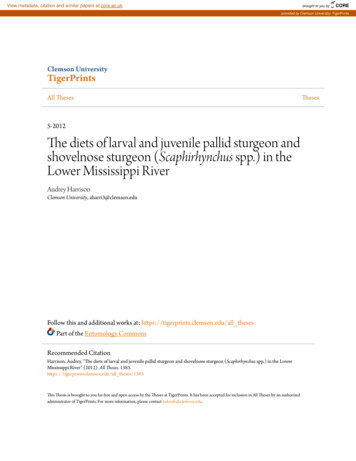
Transcription
View metadata, citation and similar papers at core.ac.ukbrought to you byCOREprovided by Clemson University: TigerPrintsClemson UniversityTigerPrintsAll Theses5-2012The diets of larval and juvenile pallid sturgeon andshovelnose sturgeon (Scaphirhynchus spp.) in theLower Mississippi RiverAudrey HarrisonClemson University, aharri3@clemson.eduFollow this and additional works at: https://tigerprints.clemson.edu/all thesesPart of the Entomology CommonsRecommended CitationHarrison, Audrey, "The diets of larval and juvenile pallid sturgeon and shovelnose sturgeon (Scaphirhynchus spp.) in the LowerMississippi River" (2012). All Theses. 1383.https://tigerprints.clemson.edu/all theses/1383This Thesis is brought to you for free and open access by the Theses at TigerPrints. It has been accepted for inclusion in All Theses by an authorizedadministrator of TigerPrints. For more information, please contact kokeefe@clemson.edu.Theses
THE DIETS OF LARVAL AND JUVENILE PALLID STURGEON ANDSHOVELNOSE STURGEON (SCAPHIRHYNCHUS SPP.)IN THE LOWER MISSISSIPPI RIVERA ThesisPresented tothe Graduate School ofClemson UniversityIn Partial Fulfillmentof the Requirements for the DegreeMaster of ScienceEntomologybyAudrey Brooke HarrisonMay 2012Accepted by:John C. Morse, Committee Co-ChairPeter H. Adler, Committee Co-ChairWilliam T. Slacki
ABSTRACTAlthough North American sturgeon have been the focus of extensive research inthe last several decades, more research is essential to ensure their conservation. Thefree-flowing Lower Mississippi River (LMR) is occupied by two sympatric sturgeon, pallid[Scaphirhynchus albus (Forbes & Richardson)] and shovelnose sturgeon [Scaphirhynchusplatorynchus (Rafinesque)]. These species are considered “endangered” and“threatened,” respectively. Recent studies have documented the life history of adultsturgeon in the Mississippi River, but studies focusing on young-of-year and juvenilesare limited because young fish are difficult to collect and identifications are problematic.Spawning sites in the LMR are unknown and though extensive effort has been put forthto capture young sturgeon for scientific study, specimens are seldom collected andrarely in large numbers. This gap in knowledge is substantial because recruitmentsuccess is important for the recovery and survival of both species. This study takes anecosystem approach in exploring microhabitat associations of larval and juvenile pallidand shovelnose sturgeon based on their diets. During systematic sampling (2001-2010)of the LMR (river kilometer 131.32-1361.18), 75 total specimens (pallid and shovelnose)were obtained using a 3.05 m modified Missouri trawl. Gut contents were analyzed andprey items were identified to the most refined taxonomic level possible. By examiningmicrohabitats and behaviors of sturgeon prey items (mostly benthicmacroinvertebrates), the microhabitat-feeding associations of sturgeon were predicted.ii
These findings suggest that both species are specific in the type of microhabitat in whichthey feed. The majority of prey items (71.8%) of both sturgeon species belong to a singlesubgroup of Chironomidae (Harnischia complex) that are predominantly burrow in sandsubstrates, typically in shifting sediments of large river systems. Several other sturgeonprey items also occupy this microhabitat. These data can be paired with collection datato assess habitat use, availability, and threats, and to make recommendations forconservation. Also studied was general early life history information related to feedingof young-of-year sturgeon. Based on this study, I conclude that larval and juvenile pallidand shovelnose sturgeon have different feeding habits than adults. This study alsoprovides an updated checklist of invertebrates known to occur in the Mississippi River.iii
DEDICATIONTo my fiancé, family, and friends, who have never stopped encouraging me topursue the things in which my passions lie, thank you all for supporting my endeavor togive a voice to the things that cannot speak for themselves. May I always strive todefend the wilderness.iv
ACKNOWLEDGEMENTSFirst, I would like to thank Dr. Bill P. Stark (Mississippi College), for providing methe opportunity and instruction to rekindle my love of insects and become a scientist,and for being an exemplary human being in all aspects.I would like to thank my advisory committee, Dr. John Morse (ClemsonUniversity) for being “right next door” and providing guidance and instruction during mywork at Clemson, Dr. Peter Adler (Clemson University) for teaching me to think byredirecting my questions, and Dr. Todd Slack (U.S. Army ERDC-EL), for keeping me on mytoes in the name of “progress.”I thank Dr. Jack Killgore (U.S. Army ERDC-EL) for providing me the opportunity toconduct this research and for being a generous leader. This project was supported bythe Mississippi Valley Division and the New Orleans District of the U.S. Army Corps ofEngineers. I thank the U.S. Army ERDC-EL Fish Ecology Team, Vicksburg, MS, for theirwork in the field collecting and processing the sturgeon used in this study and Mr.Robert Wallus for identifying these sturgeon.I thank Mr. Will Green (MS Department of Environmental Quality), Mr. CharlesWatson (U.S. Environmental Protection Agency), and Dr. Patrick McCafferty (PurdueUniversity) for providing assistance with prey item identifications.v
TABLE OF CONTENTSPageTITLE PAGE . iABSTRACT . iiDEDICATION . ivACKNOWLEDGEMENTS . vLIST OF TABLES . viiiLIST OF FIGURES . ixCHAPTERI.INTRODUCTION . 1II.LITERATURE REVIEW . 5State of the sturgeon . 5Life history of Scaphirhynchus spp. 6The Lower Mississippi River, past and present . 7Invertebrates of the Mississippi River . 9III.FEEDING HABITATS OF LARVAL AND JUVENILE PALLIDAND SHOVELNOSE STURGEON IN THE LOWERMISSISSIPPI RIVER . 10Abstract . 10Introduction . 10Materials and Methods. 12Results . 16Discussion. 25vi
Table of Contents (Continued)PageIV.INTERSPECIFIC DIETARY RELATIONSHIPS BETWEENPALLID AND SHOVELNOSE STURGEON IN THELOWER MISSISSIPPI RIVER . 28Abstract . 28Introduction . 28Materials and Methods. 30Results . 34Discussion. 38V.UPDATE TO THE MACROINVERTEBRATE FAUNA OF THEMISSISSIPPI RIVER . 39Abstract . 39Introduction . 39Materials and Methods. 41Results . 42Discussion. 43VI.SYNTHESIS . 44APENDICESA:B:C:. 46Diets of pallid sturgeon and shovelnose sturgeonreported in previous dietary analyses . 47Macroinvertebrates occurring in the Mississippi River . 51Life histories of sturgeon prey items . 63LITERATURE CITED . 67vii
LIST OF TABLESPageTable3.1Size ranges and quantities of sturgeon species analyzed . .183.2Percent composition by quantity of prey items ingestedby Lower Mississippi River sturgeon . .23Two-way frequencies of non-burrowing prey items xstream hydrograph . 253.34.1Pairwise comparison of dietary overlap (Pianka’sOverlap Index) . 34viii
LIST OF FIGURESPageFigure3.1Sampling distribution, Lower Mississippi River(river kilometer 131.32-1361.18). 183.2Habits of prey items ingested by all Scaphirhynchus spp. . 193.3Substrate associations of prey items ingested by allScaphirhynchus spp. . 193.4Substrate associations of prey items ingested bypallid sturgeon. . 203.5Habits of prey items ingested by pallid sturgeon. . 203.6Substrate associations of prey items ingested byshovelnose sturgeon. . 213.7Habits of prey items ingested by shovelnose sturgeon. . 213.8Substrate associations of prey items ingested by“undetermined” sturgeon. 223.9Habits of prey items ingested by “undetermined”sturgeon. . 224.1Similarity of prey taxa among sturgeon samples . 354.2Regression analysis of time period of fish capture xpercent total gut weight . 354.3Regression analysis of sturgeon total length (mm) xdietary species richness . 36ix
CHAPTER ONEINTRODUCTIONSturgeon (Acipenseriformes: Acipenseridae) worldwide are in peril. According tothe International Union for Conservation of Nature, “sturgeon [are] more criticallyendangered than any other group of species,” and 25 out of 29 species are listed ascritically endangered, endangered, or vulnerable for extinction (IUCN 2010). NorthAmerica is no exception. Eight out of nine species of sturgeon in the United States arelisted as either threatened or endangered in all or part of their ranges (IUCN 2011).This study focuses on two sympatric species of sturgeon in the Lower MississippiRiver, the pallid sturgeon [Scaphirhynchus albus (Forbes & Richardson)] and theshovelnose sturgeon [Scaphirhynchus platorynchus (Rafinesque)]. In 1990, the pallidsturgeon was listed as an endangered species under the Endangered Species Act of 1973(Federal Register 1990). The decline of this species was attributed to several humanimpacts, including modification of habitat and commercial harvest of the fish (FederalRegister 1990). Recently, contamination was added to the impacts on freshwatersturgeon, and is thought to cause physiological anomalies in populations includinghermaphroditic and intersexed individuals (Divers et al. 2009). In 1993, a recovery planfor the pallid sturgeon was issued by the United States Fish and Wildlife Service (1993).The plan listed recommendations and policy changes that are being implementedpresently and included a projected recovery date of 2040. Included in the list of needs1
was “information on life history and habitat requirements of all life stages of pallidsturgeon” (United States Fish and Wildlife Service 1993). This was again listed at the topof sturgeon recovery priority lists in 2005, 2007, and 2008 (Bergman et al. 2008, CERC2005, United States Fish and Wildlife Service 2007). In 2010, the shovelnose sturgeonwas listed as threatened under the Similarity-of-Appearance Provisions of theEndangered Species Act (Federal Register 2010). When working with endangered andthreatened species, all knowledge relating to the ecology, behavior, and life history ofthe animal is important and relevant.Little is known about the spawning behavior and early life histories of thesespecies, which presents a major problem when it comes to designating critical habitat toprotect them. At present, only three of nine North American sturgeon species havecritical habitat designation (United States Fish and Wildlife Service 2011a). Larval andjuvenile pallid sturgeon and shovelnose sturgeon have been studied in the upperreaches of the Mississippi River and in the Missouri River, but habitats, diets and earlylife histories of the two species have yet to be identified in the lower 1,500 riverkilometers of the Mississippi River (Braaten et al. 2007, Grohs et al. 2009, Wanner et al.2007). This stretch of the river, which extends from its confluence with the Ohio River tothe Gulf of Mexico, is where the river is deepest and widest, making sampling achallenge, especially in the benthos, where sturgeon feed (Fendeis 1997, Hoover et al.2007). Also, because spawning sites and nursery habitats are unknown in this area,larvae are collected infrequently and typically in low densities.2
Dietary studies are a useful and applied method of discovering informationabout organisms. Feeding habits define organisms—they are the basis for competition,food webs, and habitat use. Because feeding characterizes an organism, dietary studiescan answer questions concerning the types of microhabitat the organism occupies, thetime the organism most actively feeds, and any changes in diets and feeding habitats asit grows. Diet studies are also a way to collect faunistic data in habitats that scientistsare unable or unlikely to sample. In this case, sturgeon are useful study animals becausethey constantly scour the benthos in search of prey. By looking at what these immaturefish are eating, we can assess possible feeding sites and early life-history information.Additionally, distributions of prey items (e.g., invertebrates) of the Lower MississippiRiver can be assessed based on fish collection data.The specific objectives of my research concerning the diets of larval and juvenilesturgeon in the Lower Mississippi River are1.To determine the feeding habitats of larval and juvenile pallid sturgeonand shovelnose sturgeon.2.To determine the dietary overlap between larval and juvenile pallidsturgeon and shovelnose sturgeon.3.To determine changes in feeding rates based on time of day.4.To determine how diets change with growth.5.To provide updates to the known invertebrate fauna of the MississippiRiver.3
The specific hypotheses of my research of the diets of larval and juvenilesturgeon in the Lower Mississippi river are1.Feeding habitats of larval and juvenile pallid sturgeon and shovelnosesturgeon will be predictable based on the habitats of the prey items.2.Dietary overlap between the two species of sturgeon in the LowerMississippi River will be significant.3.Fish collected in the morning will have increased amounts of gut contentsrelative to those fish collected in the afternoon.4.Species richness of prey items will increase as total length of fishincreases.4
CHAPTER TWOLITERATURE REVIEWState of SturgeonSturgeon are one of the oldest living groups of vertebrate animals on the planetand have long been deemed “living fossils” because of their age—Acipenseriformes datefrom at least 200 million years before the present—and the fact that extant sturgeonare represented in the fossil record from the lower Jurassic geologic period (Birstein1993, Bemis et al. 1997, Findeis 1997). They are also the most endangered (IUCN 2010).Two species of sturgeon, the pallid sturgeon and the shovelnose sturgeon (Actiopterygii:Chondrostei: Acipenseriformes: Acipenseridae: Scaphirhynchus spp.) occupy the freeflowing Lower Mississippi River, which extends from the confluence of the Ohio River atCairo, IL, to its mouth at the Gulf of Mexico (Carlson et al. 1985, Kallemeyn 1983, UnitedStates Fish and Wildlife Service 1993). In 1990, the pallid sturgeon [Scaphirhynchus albus(Forbes and Richardson 1905)] was listed as an endangered species under theEndangered Species Act of 1973 by the United States Fish and Wildlife Service (FederalRegister 1990). The decline of this species was attributed to several human impactsincluding modification of habitat and commercial harvest of the fish (Federal Register1990). Two recent additions to the list of impacts on the species are watercontamination and hybridization between the two species (Divers et al. 2009, Tranah etal. 2004). In 1993, a recovery plan for the pallid sturgeon was issued by the U. S. Fishand Wildlife Service (1993). The plan listed recommendations and policy changes that5
are being implemented presently and included a projected recovery date of 2040.Included was the importance of gaining “information on life history and habitatrequirements of all life stages of pallid sturgeon” (United States Fish and Wildlife Service1993). In years since, the same recommendations remain, with research related to thespawning behaviors and early life history at the top of priority lists (Bergman et al. 2008,CERC 2005). In 2010, the shovelnose sturgeon [Scaphirhynchus platorynchus (Rafinesque1820)] was listed as threatened under the Similarity-of-Appearance Provisions of theEndangered Species Act of 1973 (Federal Register 2010). The decision to protect themore populous, but declining shovelnose sturgeon is based on the morphologicalsimilarity of the two species. These species are not easily distinguishable by anuntrained observer, especially the young-of-year. Pallid sturgeon and shovelnosesturgeon are typically collected at a ratio between 1:5 and 1:400, respectively,depending on location (Killgore et al. 2007). Critical habitat has not been designated foreither species in any part of their ranges (United States Fish and Wildlife Service 2011b).Life History of Scaphirhynchus spp.When working with endangered and threatened fishes, all knowledge relating tothe ecology, behavior, and life-history requirements of the animal is important andrelevant. The life histories of adult pallid sturgeon and shovelnose sturgeon have beenstudied, but unanswered questions regarding spawning behaviors, including where andwhat environmental conditions are necessary for successful spawning remain (DeLonay6
et al. 2007). Freshwater sturgeon are migratory animals and are known to travelupstream to spawn between the spring equinox and summer solstice (Wildhaber et al.2007). Female Scaphirhynchus spp. do not reach sexual maturity until ages 6-17 andspawn every 2-3 years and that males do not reach sexual maturity until ages 4-9(Colombo et al. 2007, Divers et al. 2009, Keenlyne and Jenkins 1993, Stahl 2008). Pallidand shovelnose sturgeon at lower latitudes (e.g., Lower Mississippi River) might beginspawning at an earlier age than those in upper portions of the range (e.g., Upper andMiddle Mississippi and Missouri Rivers) because they are thought to have shorterlifespans and reach smaller sizes (George et al. in press). Lower Mississippi River pallidsturgeons might be more highly fecund than those in northern portions of their range(George et al. in press).The diets of adult pallid and shovelnose sturgeon vary by species. Adult pallidsturgeon are primarily piscivorous (but still consume invertebrates), and are thought toswitch to piscivory around age 5 or 6 (Hoover et al. 2007, Grohs et al. 2009). Adultshovelnose sturgeon remain primarily invertivorous throughout all life stages (Hoover etal. 2007). The diets larval and juvenile pallid and shovelnose sturgeon in upper portionsof their ranges are much like those of the adult shovelnose sturgeon, and are primarilycomposed of aquatic insects and other benthic macroinvertebrates (Braaten et al. 2007,Grohs et al. 2009, Wanner et al. 2007). Sturgeon are benthic feeders and are welladapted morphologically (ventral positioning of the mouth, laterally compressed body)for the benthic lifestyle (Findeis 1997, United States Fish and Wildlife Service 1993). The7
diets of adult pallid and shovelnose sturgeon throughout their range, juvenile pallidsturgeon, and larval shovelnose sturgeon in the upper portions of their ranges, asrecorded in the literature, are shown in Appendix A.Lower Mississippi River, past and presentThe Lower Mississippi River is the free-flowing portion of the Mississippi Riverextending from the mouth of the Ohio River to the Gulf of Mexico (Baker et al. 1991).This stretch of river once meandered freely, flooded regularly, and was dominated bybottomland hardwood forests. Modification of the river began in the 1700s and over thelast 300 years has drastically changed the form and function of the river (ARMP 1994,Baker et al. 1991). More than 90% of the natural floodplain has been lost, denying fish,invertebrates, waterfowl, and other wetland animals millions of hectares for foraging,nesting, and spawning (ARMP 1994). As flooding decreased and human occupationincreased, ancient hardwood forests were converted to vast acreages of agriculturallands along the fertile Mississippi River Delta. This has resulted in changes in thesediment load, and the discharge of toxins (i.e., pesticides, herbicides, hormones) intothe river provide further threat to each organism that inhabits “America’s great river”(Wildhaber et al. 2007). Today, many of the banks of the Lower Mississippi River arearmored with cement to minimize erosion, stone dikes redirect water flow, levees arebuilt to counter flooding, and cutoffs are excavated at river bends to make navigationeasier (ARMP 1994). The modifications of this river system are profound, making8
conservation of its fauna a complex issue that is not likely to be resolved unless majorchanges are made to the political and economic systems of the United States. The riverat present is made up of several habitat features, including steep banks, revetments,borrow pits, main channel, lotic sandbars, lentic sandbars, pools, and other slackwaterhabitats (Baker et al. 1991).Invertebrates of the Mississippi RiverNear the bottom of the food web lie the invertebrate organisms of the riversystem. These organisms are an essential part of the nutrient cycle, which not onlysustain larger predators, but also process the organic material that is deposited into theMississippi River and its tributaries every day. The Mississippi has not been extensivelysampled for invertebrates, because of its size, but several surveys of benthicmacroinvertebrates have been conducted in the Mississippi River and those data alongwith information concerning trophic relationships, habits, and habitats of aquatic insectswill be used to make habitat predictions for prey items ingested by pallid andshovelnose sturgeon (Battle et al. 2007, Cummins 1973, Merritt et al. 2008, Payne et al.1989). A compiled list of invertebrates occurring in the Mississippi River including riverkilometers in which they were collected is included in Appendix B.9
CHAPTER THREEFEEDING HABITATS OF LARVAL AND JUVENILE PALLID AND SHOVELNOSE STURGEON INTHE LOWER MISSISSIPPI RIVERAbstractThe feeding habitats of larval and juvenile pallid sturgeon [Scaphirhynchus albus(Forbes and Richardson)] and shovelnose sturgeon [Scaphirhynchus platorynchus(Rafinesque)] from the Lower Mississippi River were evaluated. A total of 75 specimenscollected between 2001 and 2010 were dissected and gut contents were analyzed. Themicrohabitats and habits associated with sturgeon prey items were used to makepredictions about habitat use by larval and juvenile pallid and shovelnose sturgeon.These findings indicate that young pallid and shovelnose sturgeon are feeding primarilyover sandy benthos, particularly in swift currents where substrates are shifting. Themajority of prey items (71.8%) consumed by both sturgeon species belong to a singlesubgroup of Chironomidae (Diptera: Chironominae: Harnischia complex) of whichseveral genera are known to occupy this specific microhabitat.IntroductionPallid sturgeon [Scaphirhynchus albus (Forbes and Richardson)] and shovelnosesturgeon [Scaphirhynchus platorynchus (Rafinesque)] co-occur in the Lower MississippiRiver, which extends from the mouth of the Ohio River, Cairo, IL, to the Gulf of Mexico10
(Carlson et al. 1985, Kallemeyn 1983, United States Fish and Wildlife Service 1993). TheU.S. Fish and Wildlife Service listed the pallid sturgeon as an “endangered” speciesunder the Endangered Species Act in 1990 based on declining populations caused byhabitat modification, overharvest, and hybridization (Federal Register 1990). To furtherprotect the pallid sturgeon, the U.S. Fish and Wildlife Service listed the shovelnose as“threatened” under the Similarity-of-Appearance Provisions of the Endangered SpeciesAct in 2010 (Federal Register 2010). Top research priorities listed in pallid sturgeonrecovery plans include gaining information related to larvae and juveniles and habitatuse and requirements for all life stages (United States Fish and Wildlife Service 1993;Bergman et al. 2008). Dietary studies of larval, juvenile, and adult pallid and shovelnosesturgeon have been conducted in the northern portions of their range (e.g., MissouriRiver Basin and Upper Mississippi River) (Bock et al. 2011, Braaten et al. 2007, Grohs etal. 2009, Modde & Schmulbach 1977, Rapp et al. 2011, Sechler et al. 2012, Wanner et al.2007). Diets of adult sturgeon in the Lower Mississippi River (LMR) have been studied(Harrison et al. 2011, Hoover et al. 2007), but little is known about the feeding of larvaeand juveniles in this region. This uncertainty is partially due to the limited availability oflarval and juvenile sturgeon specimens, which are seldom collected and rarely in largenumbers. Identification of larval sturgeon further complicates this issue, becausemorphological characteristics distinguishing the two species at this stage ofdevelopment are not always clear and are sometimes shared (Snyder 2002).11
To protect these species and ensure successful recruitment of young sturgeon inthe LMR, the early life histories must be investigated and habitat requirements must bebetter understood. Dietary studies can be effective in making life-history discoveries andhabitat predictions (Hyslop 1980), and these approaches have been used successfullywith sturgeon species (Mason & Clugston 1993, Keevin et al. 2007, Rapp et al. 2011). Tomaximize the success of this methodology, prey items must be identified to the mostrefined taxonomic level possible, preferably genus or species, as suggested by Rapp etal. (2011). Life histories of potential prey taxa can differ significantly among genera andeven species, especially in large families such as the Chironomidae (Diptera) (Bailey etal. 2001). This study takes an ecosystem approach to learning more about habitat use bylarval and juvenile sturgeon based on their diets. The specific objectives of this studyare to 1) compare dietary components of sampled sturgeon species with compiled listsof known habitat associations of ingested prey items, and 2) to identify respectiveriverine habitats of young river sturgeon based on these associations. By investigatingthe habitat requirements, habits, and feeding groups of sturgeon prey items, feedinghabits and microhabitats can be better understood and thus provide more definedtargets for conservation.Materials and MethodsSturgeon specimens (Scaphirhynchus spp.) were collected between 2001 and2010 (February-October) using a 3.05 m modified Missouri trawl with 6.35-mm mesh12
outside and 25.4-mm mesh inside (Herzog et al. 2009), pulled approximately 1.6 km perhaul along benthic substrates in the Lower Mississippi River (Fig. 1). This approach hasbeen successful for sampling small sturgeon in rivers of the Mississippi River basin(Herzog et al. 2005; Hrabik et al. 2007) and the Gulf Coastal plain (Kirk et al. in press).Larval and juvenile fishes were immediately placed in either 95% ethanol solution orbuffered formalin solut
work at Clemson, Dr. Peter Adler (Clemson University) for teaching me to think by redirecting my questions, and Dr. Todd Slack (U.S. Army ERDC-EL), for keeping me on my toes in the name of "progress." I thank Dr. Jack Killgore (U.S. Army ERDC-EL) for providing me the opportunity to conduct this research and for being a generous leader.




